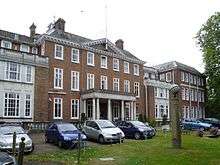Arnos Grove house

Arnos Grove, originally known as Arnolds, is a grade II* listed house in Cannon Hill, London.[1][2]
History
_p5.099_-_Arno's_Grove%2C_Middlesex.jpg)
The house was built after the London banker James Colebrooke bought the Arnolds estate in 1719[3] or 1720.[4]
Locals called the estate Arno’s and the next owner, Sir William Mayne (later Lord Newhaven), renamed the house and estate Arnos Grove, which is now pronounced as though it never had an apostrophe.[5] In 1777, it was bought by Isaac Walker.[6]
The mansion was described in 1821 by Edward Mogg in Paterson's Roads as:[7]
containing many apartments, equally conspicuous for size, elegance, and that air of close domestic comfort so extremely desirable in the ever-varying climate of this country; these were highly adorned by the refined taste and liberality of the late proprietor [Mr Walker] and exhibit, besides a select and valuable collection of paintings, numerous Etruscan vases and other antiquities from Herculaneum and Pompeii, about 4000 specimens of choice minerals, scientifically arranged, and a beautiful cabinet of maple-wood, in which there is a vast number of scarce and estimable shells. The paintings of the staircase, executed by Lanscroon, a pupil of Verrio, in 1723, and representing the triumphal entry of Julius Caesar into Rome, and the apotheosis of that hero, are in good preservation, and may be considered, with the exception of those in the royal palaces, the best staircase decorations now remaining in Middlesex. Several of the principal apartments are fitted up in a costly but delicate style; there is a fine chimneypiece of Sicilian jasper in the dining room, which was executed in Italy, and comprises a beautiful mask of Apollo, in statuary marble; the chimneypiece of the drawing room is likewise of Sicilian jasper, and this apartment is adorned with pillars and pilasters, imitative of the same material.
The estate was owned from 1777 to 1918 by Walkers of the Taylor Walker brewing family (including the Walkers of Southgate), who bought the nearby Minchenden estate to increase the area of Arnos Grove to over 300 acres (1.2 km2). The New River loop ran through the Arnos Grove estate until the nineteenth century. The estate was then purchased from the last of the Walker brothers by Lord Inverforth who sold the southernmost 44 acres (180,000 m2) to the Southgate Urban District Council, which created Arnos Park in 1928, and property developers.[8]
Upon the death of Taylor Walker in 1918, Arnos Grove was left to his son Richard Walker while he was still 18.

The Arnos Grove mansion was also sold in 1928 to the North Metropolitan Electricity Supply Company. The mansion was subsequently enlarged, with an extension to the south in 1929 followed by one at the north end of the house in 1935, resulting in loss of the portico facing Southgate Green,[9] and encased in red brick. The house was sold to Legal & General in 1975 and renamed Southgate House.[9] In 1997-8 the bulk of the property was converted into a residential care home called Southgate Beaumont[5] with the southern part developed into luxury apartments.[9]
See also
References
- ↑ "FORMERLY ARNOS GROVE SOUTHGATE HOUSE (CENTRAL SECTION) - 1294639". Historic England. Retrieved 28 July 2016.
- ↑ "Arnos Park". London Gardens Online. Retrieved 28 July 2016.
- ↑ Willey, Russ. (2006) Chambers London Gazetteer. London: Chambers. p. 14. ISBN 9780550102591
- ↑ Dumayne, Alan. (1987) Southgate: A glimpse into the past. Alan Dumayne, London, 1987. p. 124. ISBN 0951228609
- 1 2 Hidden London - Arnos Grove.
- ↑ The Walkers. Southgate Green Association. Retrieved 2 December 2017.
- ↑ Mogg, Edward. Paterson's Roads (1829 ed.). A. & R. Spottiswoode. p. 308.
- ↑ Park Explorer - Arnos Park.
- 1 2 3 "London Gardens Online". www.londongardensonline.org.uk. Retrieved 2 December 2017.
External links
![]()